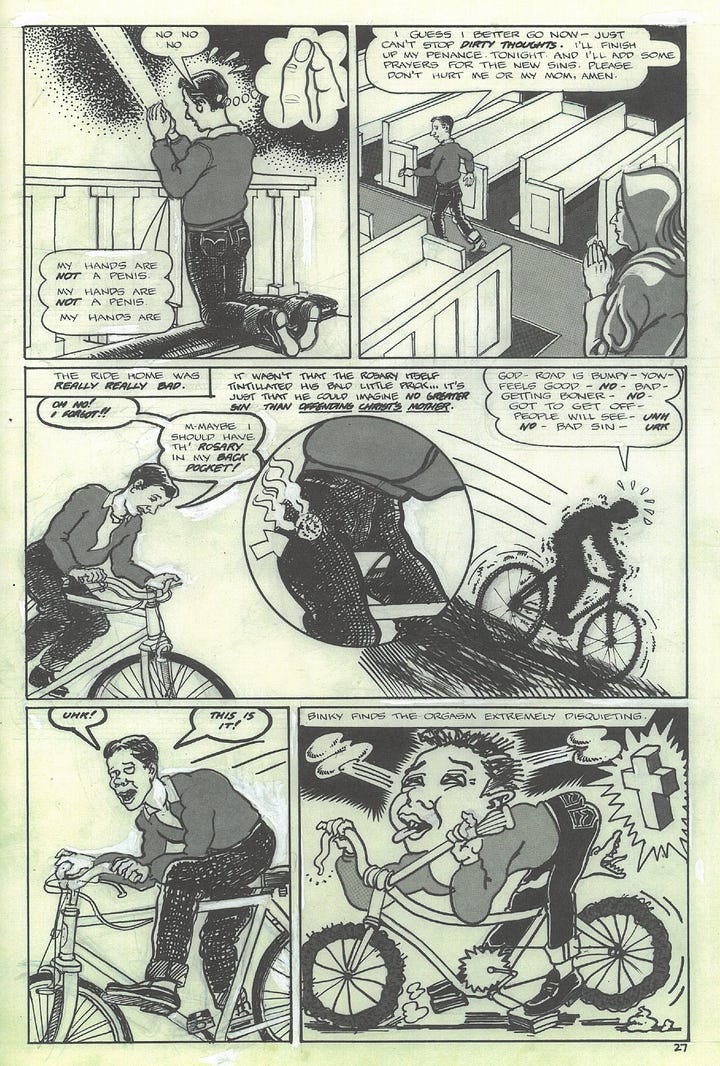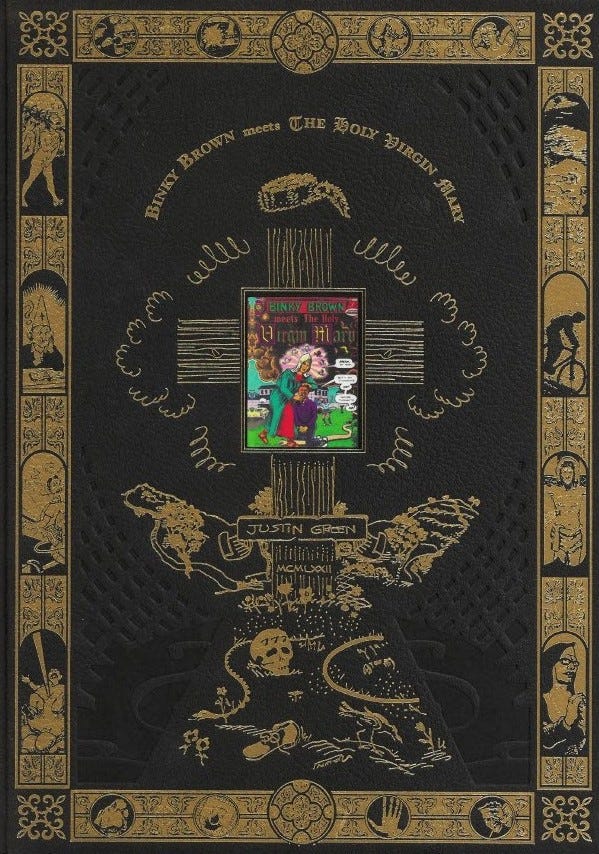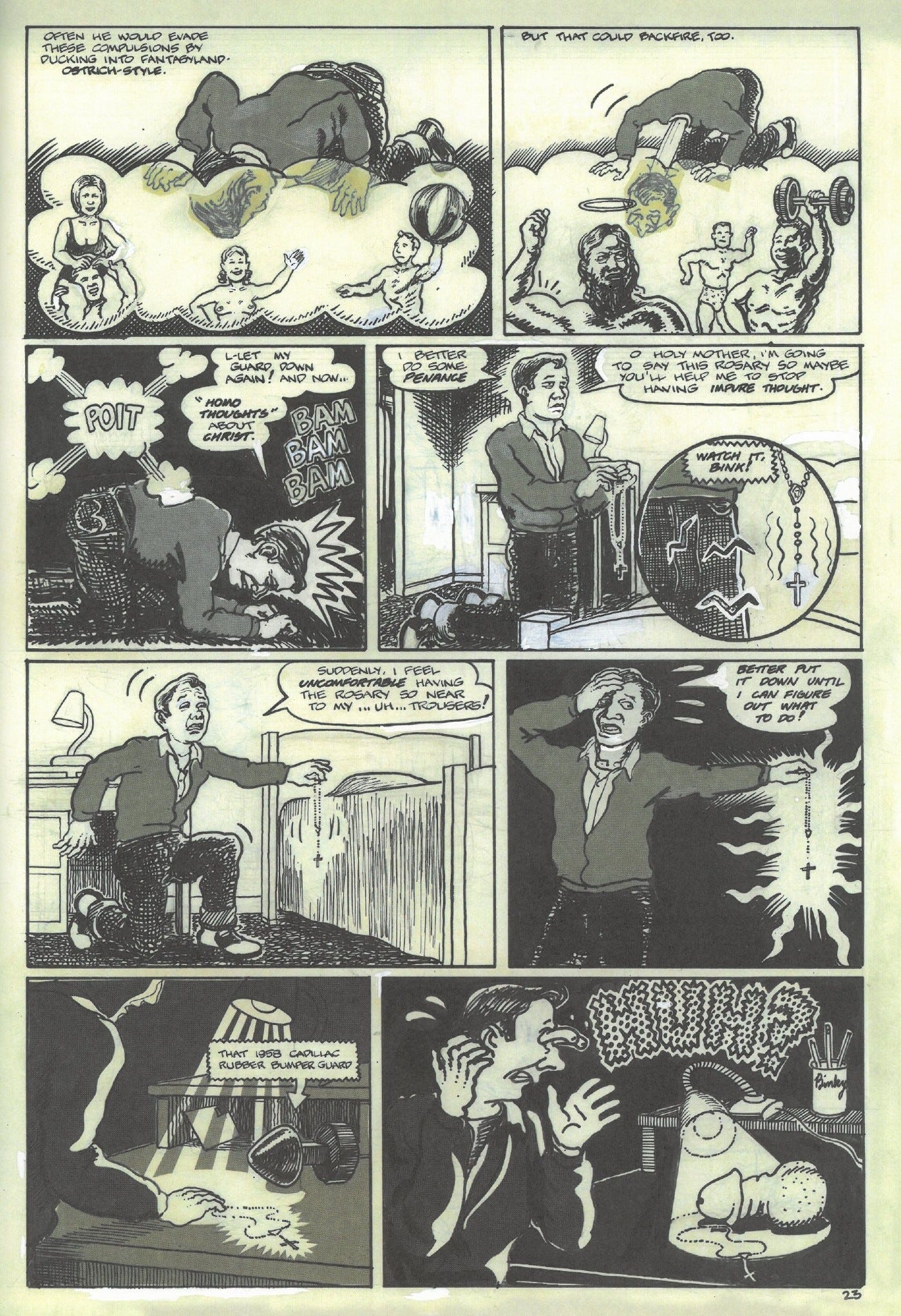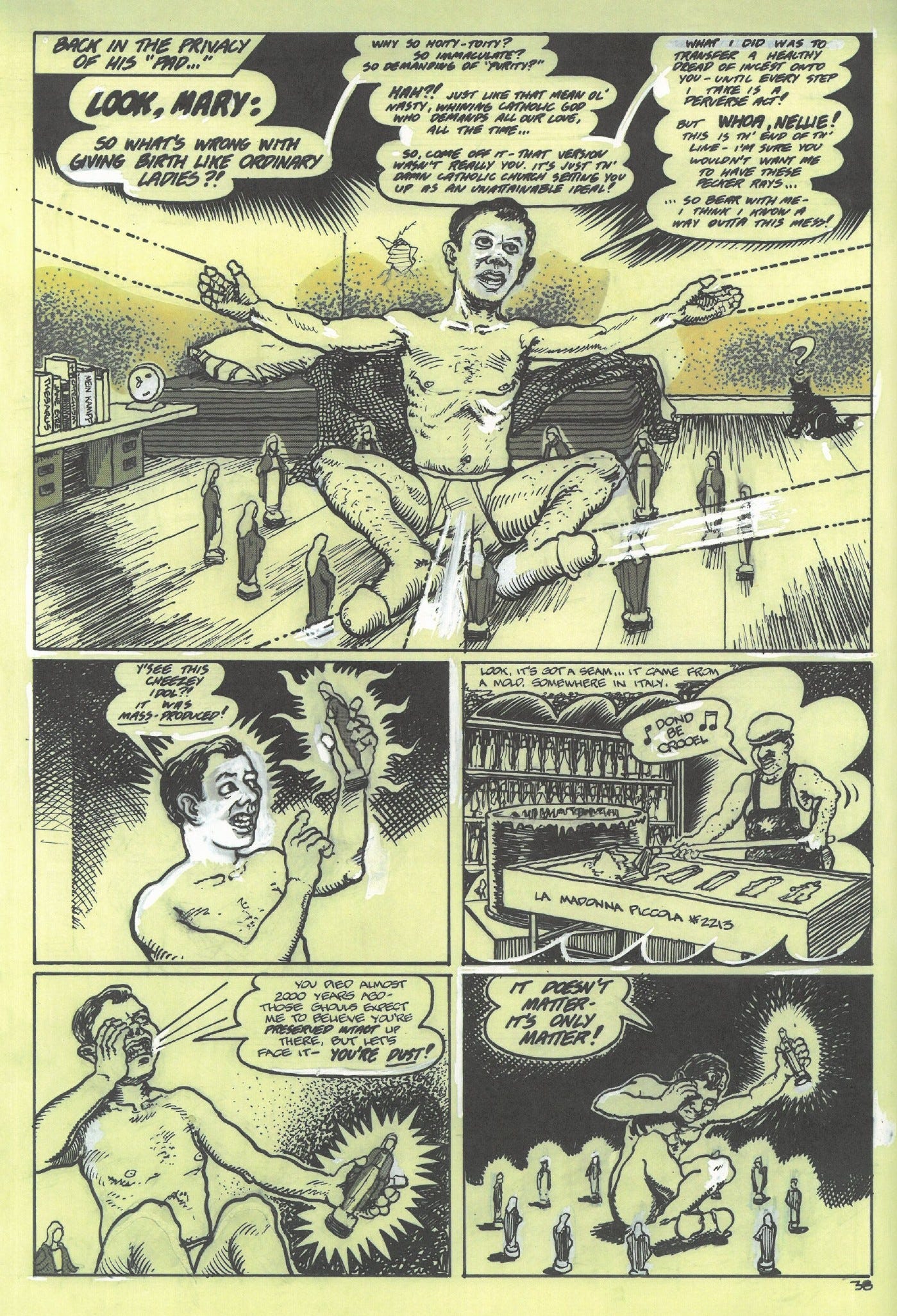Binky Brown Meets the Holy Virgin Mary by Justin Green was the first autobiographical comic book published in English. The year was 1972 and Green was a part of the underground comics movement. The edition pictured above was published by McSweeney’s Books in 2009. The original comic book was a modest 44-page production while the McSweeney’s is an oversized edition shot from Green’s original art. Of course, the original 1972 was shot from Green’s original art, but the McSweeney’s shows all the white out and corrections that Green made in the process of creating the work. To my mind, the real version of Binky Brown Meets the Holy Virgin Mary is the cheap floppy comic book (long out of print and no longer cheap.)
Very briefly, Green as a young boy (called Binky here) begins to develop an obsession with “sin” which he perceives as “rays” emanating from his penis. He had been a confused boy from a religiously mixed household—his father was Jewish and his mother a devout Catholic. He went to a Catholic school and both worshipped and feared the nuns who taught him. His favorite nun was Sister Virginia and he is shocked when he doesn’t recognize her after she reintroduces herself to him as an ex-nun. He condemns her in his mind as a weakling who broke a promise to God. He asks a nun in class one day, “Can’t Moslems [sic] or uh — Jewish people—go to heaven and get to see God even if they’re good?” The answer is no—his dad is condemned to Hell.
Green also shows us Binky’s sexual awakening, including his first orgasm. Young Binky is shown a gruesome image of the battle of Little Big Horn and is shocked at the sight of George Custer’s scalped head. That night he goes to sleep holding a pig-shaped eraser and scrapes off a little bit of it. That action makes him think of the image of Custer’s scalped skull, which makes him orgasm. In this whole concatenation of events, there is nothing sexual.
Binky starts having sexual feelings about other people. He constructs elaborate scenarios to imagine sex. Green associates these scenarios with Catholic guilt, but I think such weird fantasies are a normal result of sexual inexperience.
Binky Brown’s school days are a continual struggle against sexual thoughts, partially controlled by constant prayer. There is an incident where Binky becomes obsessed with the black rubber guards that came on 1950s Cadillacs. They were a weird decoration that came with the El Dorado model of Cadillac, giving the cars a pair of black breasts. Green associates his inexplicable fascination with these black rubber objects with the pig eraser he fondled during his first orgasm. But while the pig was non-sexual, the bumper guard reminds him simultaneously of a penis and a woman’s breast.
The rubber bumper guard is the inciting incident. His constant thoughts of sex start to go beyond adolescent fascination into a life-controlling mental illness. He imagines a ray emanating from his crotch, and wherever that ray intersects something holy, like a church, Binky imagines he is doing harm to himself and his family. The imagined rays eventually spread so that they are emanating from his fingers and feet as well as his penis. This is extremely inconvenient for him when he attends mass.


At this point, the reader will have realized that it wasn’t Catholic guilt that was causing Green’s “penis ray” problem—it is obsessive convulsive disorder. Interestingly when the disease was first described by Robert Burton in the 17th century, he called it “religious melancholy.” In a sermon from 1691, John Moore, Bishop of Norwich, England, spoke of afflicted persons as possessing “naughty, and sometimes Blasphemous Thoughts [which] start in their Minds, while they are exercised in the Worship of God [despite] all their endeavours to stifle and suppress them ... the more they struggle with them, the more they encrease.” Moore had Binky pegged 250 years before Binky Brown Meets the Holy Virgin Mary.
Green left the church in 1958 when he was 13, but his OCD symptoms still bedeviled him. He spends years in apparently futile attempts to cope, many of which place him as a full-fledged member of the counter culture. Some of his coping mechanisms involved self-numbing through drugs, others through non-Catholic religious practices, and others through art. Even psychiatry doesn’t help.
In the end, Binky buys a dozen 39 cent Madonnas from a Catholic Supply Store and has a kind of exorcism. While this ritual (and the comic book that Green drew) have the intent of curing Binky’s obsession, I think we all know that this is not how you recover from mental illness. You don’t beat the devil with one dramatic act.
After he drew Binky Brown Meets the Holy Virgin Mary, Green became aware that his problem had nothing to do Catholicism. I don’t know what Green did to cope with his OCD, but he somehow managed it for another 50 years. He died in 2022.
The comics world had never seen a confessional autobiographical story like this. His influence was instantaneous. Art Spiegelman has spoken of Green’s influence on him, and the first version of Maus, just a few pages, was also published in 1972 in a underground comix anthology, Funny Aminals, to which Green also contributed. The underground comix prior to 1972 had already shattered every sexual taboo. Green turned that examination of sex that inward.
Binky Brown Meets the Holy Virgin Mary was pretty much it for Green. He produced one more great comic book, Sacred and Profane: Mortal and Venial Comic Stories, and various short stories in comix anthologies of the 70s. Despite having a degree from the Rhode Island School of Design, Green became a sign painter, choosing a career that was already headed for extinction in the 70s. Like virtually all underground cartoonists, he had a resentment toward the fine art world—partially class based. Later in life he drew comics for a trade publication for the sign business. Like many artists with an early masterpiece, Green was content to let Binky be his legacy. He became a much loved elder statesman.
Interestingly, in the 1980s, he met and married Carol Tyler, another cartoonist whose work I have also placed in this series about 100 important comics works. Binky Brown Meets the Holy Virgin Mary is one of the most influential comics ever drawn, but Carol Tyler’s body of work is the more important artistically.
Furthermore, I am of the opinion that Trump must go.
[Please consider supporting this publication by becoming a patron, and you can also support it by patronizing our online store. And one more way to support this work is to buy books through The Great God Pan is Dead’s bookstore. ]










